Characterization of Charge States in Conducting Organic Nanoparticles by X-ray Photoemission Spectroscopy
Abstract
1. Introduction
2. Materials and Methods
3. Results and Discussion
3.1. Charge Transfer in Nanoparticles of TTF-TCNQ
3.2. Electron Binding Energies of Neutral Molecules
3.3. Mixed Valency in Nanoparticles of β-(BEDT-TTF)2I3
4. Conclusions
Supplementary Materials
Author Contributions
Funding
Institutional Review Board Statement
Informed Consent Statement
Data Availability Statement
Acknowledgments
Conflicts of Interest
References
- Siegbahn, K. Electron spectroscopy—An outlook. J. Electron Spectrosc. Relat. Phenom. 1974, 5, 3–97. [Google Scholar] [CrossRef]
- Fadley, C.; Fadley, C. X-ray photoelectron spectroscopy: Progress and perspectives. J. Electron Spectrosc. Relat. Phenom. 2010, 178–179, 2–32. [Google Scholar] [CrossRef]
- van der Heide, P. X-ray Photoelectron Spectroscopy: An Introduction to Principles and Practices; John Wiley & Sons, Inc.: Hoboken, NJ, USA, 2012. [Google Scholar]
- Baer, D.R. Guide to making XPS measurements on nanoparticles. J. Vac. Sci. Technol. A 2020, 38, 031201. [Google Scholar] [CrossRef]
- Greczynski, G.; Hultman, L. X-ray photoelectron spectroscopy: Towards reliable binding energy referencing. Prog. Mater. Sci. 2020, 107, 100591. [Google Scholar] [CrossRef]
- Winter, B.; Faubel, M. Photoemission from Liquid Aqueous Solutions. Chem. Rev. 2006, 106, 1176–1211. [Google Scholar] [CrossRef]
- Salmeron, M.; Schlogl, R. Ambient pressure photoelectron spectroscopy: A new tool for surface science and nanotechnology. Surf. Sci. Rep. 2008, 63, 169–199. [Google Scholar] [CrossRef]
- Pellegrin, E.; Perez-Dieste, V.; Escudero, C.; Rejmak, P.; Gonzalez, N.; Fontsere, A.; Prat, J.; Fraxedas, J.; Ferrer, S. Water/methanol solutions characterized by liquid μ-jet XPS and DFT—The methanol hydration case. J. Mol. Liq. 2020, 300, 112258. [Google Scholar] [CrossRef]
- Amann, P.; Degerman, D.; Lee, M.-T.; Alexander, J.D.; Shipilin, M.; Wang, H.-Y.; Cavalca, F.; Weston, M.; Gladh, J.; Blom, M.; et al. A high-pressure X-ray photoelectron spectroscopy instrument for studies of industrially relevant catalytic reactions at pressures of several bars. Rev. Sci. Instrum. 2019, 90, 103102. [Google Scholar] [CrossRef]
- Divins, N.J.; Angurell, I.; Escudero, C.; Pérez-Dieste, V.; Llorca, J. Influence of the support on surface rearrangements of bimetallic nanoparticles in real catalysts. Science 2014, 346, 620–623. [Google Scholar] [CrossRef]
- Lasemi, N.; Rupprechter, G. Chemical and Laser Ablation Synthesis of Monometallic and Bimetallic Ni-Based Nanoparticles. Catalysts 2020, 10, 1453. [Google Scholar] [CrossRef]
- Kar, A.; Sain, S.; Rossouw, D.; Knappett, B.R.; Pradhan, S.K.; Wheatley, A.E.H. Facile synthesis of SnO2–PbS nanocomposites with controlled structure for applications in photocatalysis. Nanoscale 2016, 8, 2727–2739. [Google Scholar] [CrossRef]
- Fang, Y.; Cheng, Z.; Wang, S.; Hao, H.; Li, L.; Zhao, S.; Chu, X.; Zhu, R. Effects of oxidation on the localized surface plasmon resonance of Cu nanoparticles fabricated via vacuum coating. Vacuum 2021, 184, 109965. [Google Scholar] [CrossRef]
- Guler, U.; Shalaev, V.M.; Boltasseva, A. Nanoparticle plasmonics: Going practical with transition metal nitrides. Mater. Today 2015, 18, 227–237. [Google Scholar] [CrossRef]
- Elayappana, V.; Muthusamyb, S.; Mayakrishnanc, G.; Balasubramaniamd, R.; Leed, Y.-S.; Noh, H.S.; Kwona, D.; Mussa, M.M.; Leea, H. Ultrasonication–dry-based synthesis of gold nanoparticle-supported CuFe on rGO nanosheets for competent detection of biological molecules. Appl. Surf. Sci. 2020, 531, 147415. [Google Scholar] [CrossRef]
- Yang, Z.; Zhang, D.; Chen, H. MOF-derived indium oxide hollow microtubes/MoS2 nanoparticles for NO2 gas sensing. Sens. Actuators B Chem. 2019, 300, 127037. [Google Scholar] [CrossRef]
- Canevari, T.C.; Cincotto, F.H.; Gomes, D.; Landers, R.; Toma, H.E. Magnetite Nanoparticles Bonded Carbon Quantum Dots Magnetically Confined onto Screen Printed Carbon Electrodes and their Performance as Electrochemical Sensor for NADH. Electroanalysis 2017, 29, 1968–1975. [Google Scholar] [CrossRef]
- Pang, Q.; Tang, J.; Huang, H.; Liang, X.; Hart, C.; Tam, K.C.; Nazar, L.F. A Nitrogen and Sulfur Dual-Doped Carbon Derived from Polyrhodanine@Cellulose for Advanced Lithium-Sulfur Batteries. Adv. Mater. 2015, 27, 6021–6028. [Google Scholar] [CrossRef]
- Maliszewska, I.; Wanarska, E.; Tylus, W. Sulfonated hydroxyaluminum phthalocyanine-biogenic Au/Ag alloy nanoparticles mixtures for effective photo-eradication of Candida albicans. Photodiagnosis Photodyn. Ther. 2020, 32, 102016. [Google Scholar] [CrossRef] [PubMed]
- Pujals, S.; Bastus, N.G.; Pereiro, E.; Puntes, V.F.; Kogan, M.J.; Giralt, E.; López-Iglesias, C. Shuttling Gold Nanoparticles into Tumoral Cells with an Amphipathic Proline-Rich Peptide. ChemBioChem 2009, 10, 1025–1031. [Google Scholar] [CrossRef]
- Asmat-Campos, D.; Abreu, A.C.; Romero-Cano, M.S.; Urquiaga-Zavaleta, J.; Contreras-Cáceres, R.; Delfín-Narciso, D.; Juárez-Cortijo, L.; Nazario-Naveda, R.; Rengifo-Penadillos, R.; Fernández, I. Unraveling the Active Biomolecules Responsible for the Sustainable Synthesis of Nanoscale Silver Particles through Nuclear Magnetic Resonance Metabolomics. ACS Sustain. Chem. Eng. 2020, 8, 17816–17827. [Google Scholar] [CrossRef]
- Lafuente, M.; Pellejero, I.; Clemente, A.; Urbiztondo, M.A.; Mallada, R.; Reinoso, S.; Pina, M.P.; Gandía, L.M. In Situ Synthesis of SERS-Active Au@POM Nanostructures in a Microfluidic Device for Real-Time Detection of Water Pollutants. ACS Appl. Mater. Interfaces 2020, 12, 36458–36467. [Google Scholar] [CrossRef]
- Liu, Y.; Chen, G.; Tian, C.; Gupta, R.; Wang, X.; Zeng, H. Metal oxide nanoparticle-modified graphene oxide for removal of elemental mercury. Environ. Technol. 2018, 40, 3602–3610. [Google Scholar] [CrossRef]
- Fraxedas, J. Molecular Organic Materials; Cambridge University Press (CUP): Cambridge, UK, 2006. [Google Scholar]
- Chappell, J.S.; Bloch, A.N.; Bryden, W.A.; Maxfield, M.; Poehler, T.O.; Cowan, D.O. Degree of charge transfer in organic conductors by infrared absorption spectroscopy. J. Am. Chem. Soc. 1981, 103, 2442–2443. [Google Scholar] [CrossRef]
- Kistenmacher, T.J.; Phillips, T.E.; Cowan, D.O. The crystal structure of the 1:1 radical cation–radical anion salt of 2, 2′-bis-l, 3-dithiole (TTF) and 7, 7, 8, 8-tetracyanoquinodimethane (TCNQ). Acta Cryst. B 1974, 30, 763–768. [Google Scholar] [CrossRef]
- Ishiguro, T.; Yamaji, K.; Little, W.A. Organic Superconductors. Phys. Today 1991, 44, 104–107. [Google Scholar] [CrossRef]
- De Caro, D.; Souque, M.; Faulmann, C.; Coppel, Y.; Valade, L.; Fraxedas, J.; Vendier, O.; Courtade, F. Colloidal Solutions of Organic Conductive Nanoparticles. Langmuir 2013, 29, 8983–8988. [Google Scholar] [CrossRef] [PubMed]
- De Caro, D.; Valade, L.; Faulmann, C.; Jacob, K.; Van Dorsselaer, D.; Chtioui, I.; Salmon, L.; Sabbar, A.; El Hajjaji, S.; Pérez, E.; et al. Nanoparticles of molecule-based conductors. New J. Chem. 2013, 37, 3331–3336. [Google Scholar] [CrossRef]
- De Caro, D.; Faulmann, C.; Valade, L.; Jacob, K.; Chtioui, I.; Foulal, S.; De Caro, P.; Bergez-Lacoste, M.; Fraxedas, J.; Ballesteros, B.; et al. Four Molecular Superconductors Isolated as Nanoparticles. Eur. J. Inorg. Chem. 2014, 2014, 4010–4016. [Google Scholar] [CrossRef]
- Chtioui-Gay, I.; Faulmann, C.; De Caro, D.; Jacob, K.; Valade, L.; Fraxedas, J.; Ballesteros, B.; Steven, E.; Choi, E.S.; Lee, M.; et al. Synthesis, characterization, and thermoelectric properties of superconducting (BEDT-TTF)2I3 nanoparticles. J. Mater. Chem. C 2016, 4, 7449–7454. [Google Scholar] [CrossRef]
- Cormary, B.; Faulmann, C.; De Caro, D.; Valade, L.; De Caro, P.; Ballesteros, B.; Fraxedas, J. Facile synthesis of nanoparticles of the molecule-based superconductor κ-(BEDT-TTF)2Cu(NCS)2. Comptes Rendus Chim. 2018, 21, 809–813. [Google Scholar] [CrossRef]
- Fraxedas, J.; García-Gil, S.; Monturet, S.; Lorente, N.; Fernández-Torrente, I.; Franke, K.J.; Pascual, J.I.; Vollmer, A.; Blum, R.-P.; Koch, N.; et al. Modulation of Surface Charge Transfer through Competing Long-Range Repulsive versus Short-Range Attractive Interactions. J. Phys. Chem. C 2011, 115, 18640–18648. [Google Scholar] [CrossRef]
- Major, G.H.; Avval, T.G.; Moeini, B.; Pinto, G.; Shah, D.; Jain, V.; Carver, V.; Skinner, W.; Gengenbach, T.R.; Easton, C.D.; et al. Assessment of the frequency and nature of erroneous X-ray photoelectron spectroscopy analyses in the scientific literature. J. Vac. Sci. Technol. A 2020, 38, 061204. [Google Scholar] [CrossRef]
- Fraxedas, J.; Trodahl, J.; Gopalan, S.; Ley, L.; Cardona, M. Temperature dependence of direct transitions in angle-resolved photoemission and its application to InSb. Phys. Rev. B 1990, 41, 10068–10081. [Google Scholar] [CrossRef] [PubMed]
- Shi, Y.-R.; Liu, Y.-F. Theoretical study on the charge transport and metallic conducting properties in organic complexes. Phys. Chem. Chem. Phys. 2019, 21, 13304–13318. [Google Scholar] [CrossRef]
- Sing, M.; Schwingenschlögl, U.; Claessen, R.; Dressel, M.; Jacobsen, C.S. Surface characterization and surface electronic structure of organic quasi-one-dimensional charge transfer salts. Phys. Rev. B 2003, 67, 125402. [Google Scholar] [CrossRef]
- Subías, G.; Abbaz, T.; Fabre, J.M.; Fraxedas, J. Characterization of the anion-ordering transition in (TMTTF)2ReO4 by X-ray absorption and photoemission spectroscopies. Phys. Rev. B 2007, 76, 085103. [Google Scholar] [CrossRef]
- Rojas, C.; Caro, J.; Grioni, M.; Fraxedas, J. Surface characterization of metallic molecular organic thin films: Tetrathiafulvalene tetracyanoquinodimethane. Surf. Sci. 2001, 482–485, 546–551. [Google Scholar] [CrossRef]
- Lindquist, J.M.; Hemminger, J.C. High-resolution core level photoelectron spectra of solid TCNQ: Determination of molecular orbital spatial distribution from localized shake-up features. J. Phys. Chem. 1988, 92, 1394–1396. [Google Scholar] [CrossRef]
- Graf, N.; Yegen, E.; Gross, T.; Lippitz, A.; Weigel, W.; Krakert, S.; Terfort, A.; Unger, W.E. XPS and NEXAFS studies of aliphatic and aromatic amine species on functionalized surfaces. Surf. Sci. 2009, 603, 2849–2860. [Google Scholar] [CrossRef]
- Fernandez-Torrente, I.; Monturet, S.; Franke, K.J.; Fraxedas, J.; Lorente, N.; Pascual, J.I. Long-Range Repulsive Interaction between Molecules on a Metal Surface Induced by Charge Transfer. Phys. Rev. Lett. 2007, 99, 176103. [Google Scholar] [CrossRef] [PubMed]
- Zharnikov, M.; Grunze, M. Spectroscopic characterization of thiol-derived self-assembling monolayers. J. Phys. Condens. Matter 2001, 13, 11333–11365. [Google Scholar] [CrossRef]
- Rodríguez, J.A.; Dvorak, J.; Jirsak, T.; Liu, G.; Hrbek, J.; Aray, Y.; González, C. Coverage Effects and the Nature of the Metal− Sulfur Bond in S/Au (111): High-Resolution Photoemission and Density-Functional Studies. J. Am. Chem. Soc. 2003, 125, 276–285. [Google Scholar] [CrossRef]
- Heimel, G.; Romaner, L.; Brédas, J.L.; Zojer, E. Organic/metal interfaces in self-assembled monolayers of conjugated thiols: A first-principles benchmark study. Surf. Sci. 2006, 600, 4548–4562. [Google Scholar] [CrossRef]
- Bröker, B.; Blum, R.-P.; Frisch, J.; Vollmer, A.; Hofmann, O.T.; Rieger, R.; Müllen, K.; Rabe, J.P.; Zojer, E.; Koch, K. Gold work function reduction by 2.2 eV with an air-stable molecular donor layer. Appl. Phys. Lett. 2008, 93, 243303. [Google Scholar] [CrossRef]
- Itti, R.; Mori, H.; Ikeda, K.; Hirabayashi, I.; Koshizuka, N.; Tanaka, S. Photoelectron spectroscopic study of kappa-(BEDT-TTF)2Cu(NCS)2 organic superconductor. Phys. C 1991, 185–189, 2673–2674. [Google Scholar] [CrossRef]
- Kurmaev, E.Z.; Moewes, A.; Chiuzbian, S.G.; Finkelstein, L.D.; Neumann, M.; Turner, S.S.; Day, P. Valence-band spectra of BEDT-TTF and TTF-based magnetic charge-transfer salts. Phys. Rev. B 2002, 65, 235106. [Google Scholar] [CrossRef]
- Arbman, M.; Holmberg, S.; Lundholm, M.; Siegbahn, H.; Gropen, O.; Wahlgren, U. Liquid ESCA measurements and ECP calculations on the 3d spectrum of I3−. Chem. Phys. 1983, 81, 113–119. [Google Scholar] [CrossRef]
- Men, S.; Lovelock, K.R.; Licence, P. X-ray photoelectron spectroscopy of trihalide ionic liquids: Comparison to halide-based analogues, anion basicity and beam damage. Chem. Phys. Lett. 2017, 679, 207–211. [Google Scholar] [CrossRef]
- Chilkoti, A.; Ratner, B.D. X-ray photoelectron spectroscopy of iodine-doped nonconjugated polymers. Chem. Mater. 1993, 5, 786–792. [Google Scholar] [CrossRef]
- Winter, L.E.; Steven, E.; Brooks, J.S.; Benjamin, S.; Park, J.-H.; De Caro, D.; Faulmann, C.; Valade, L.; Jacob, K.; Chtioui, I.; et al. Spin density wave and superconducting properties of nanoparticle organic conductor assemblies. Phys. Rev. B 2015, 91, 035437. [Google Scholar] [CrossRef]
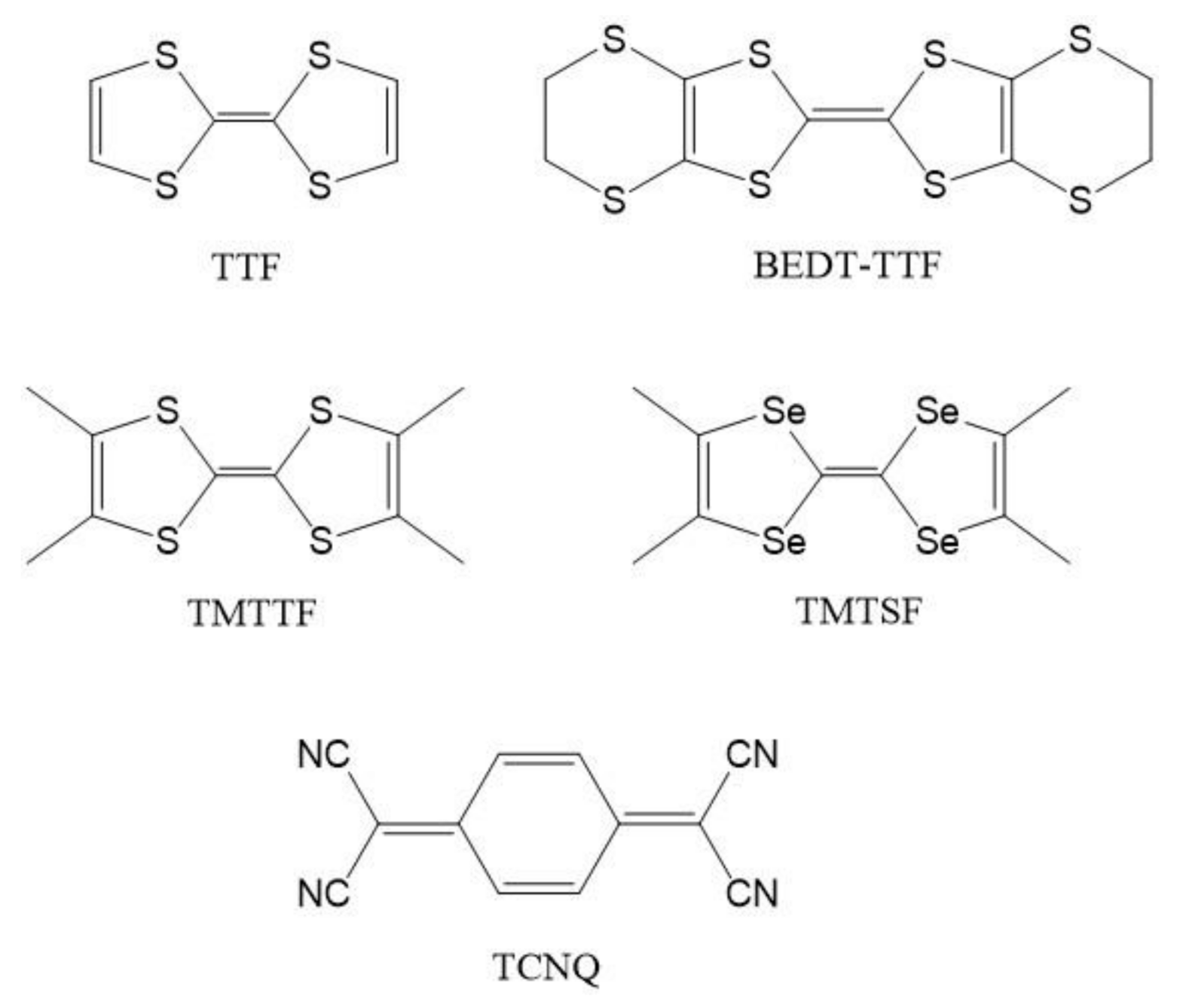
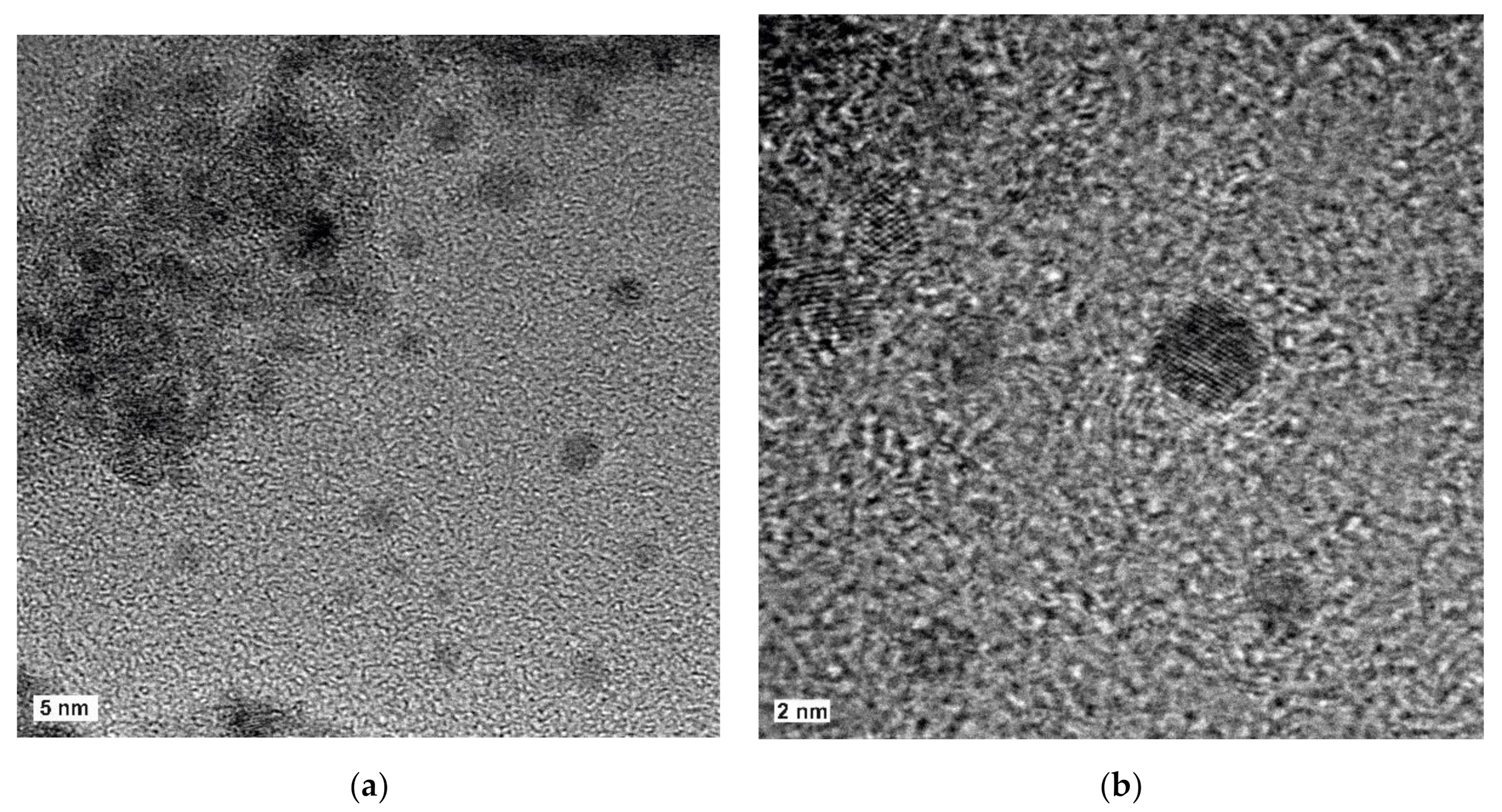
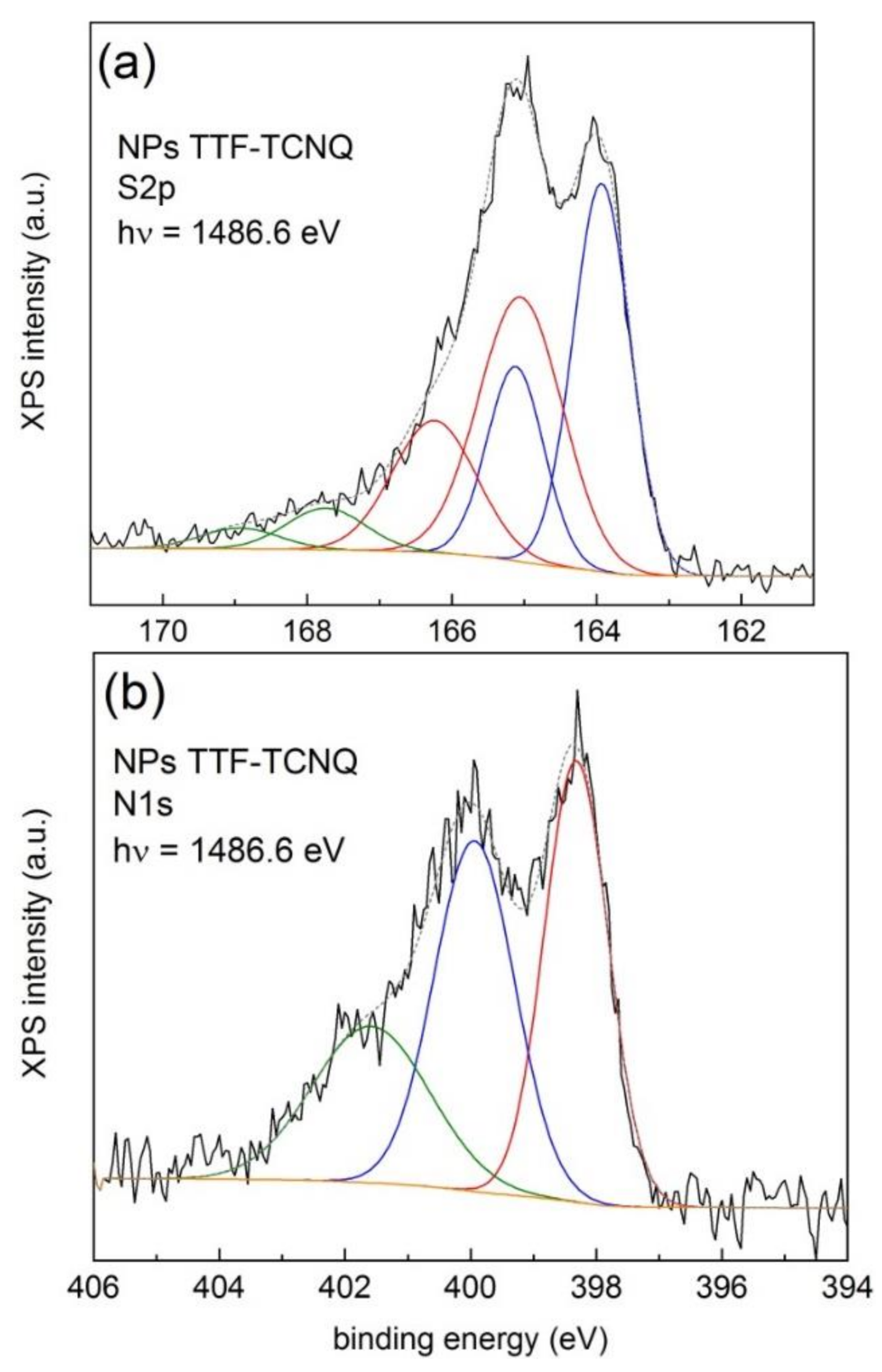
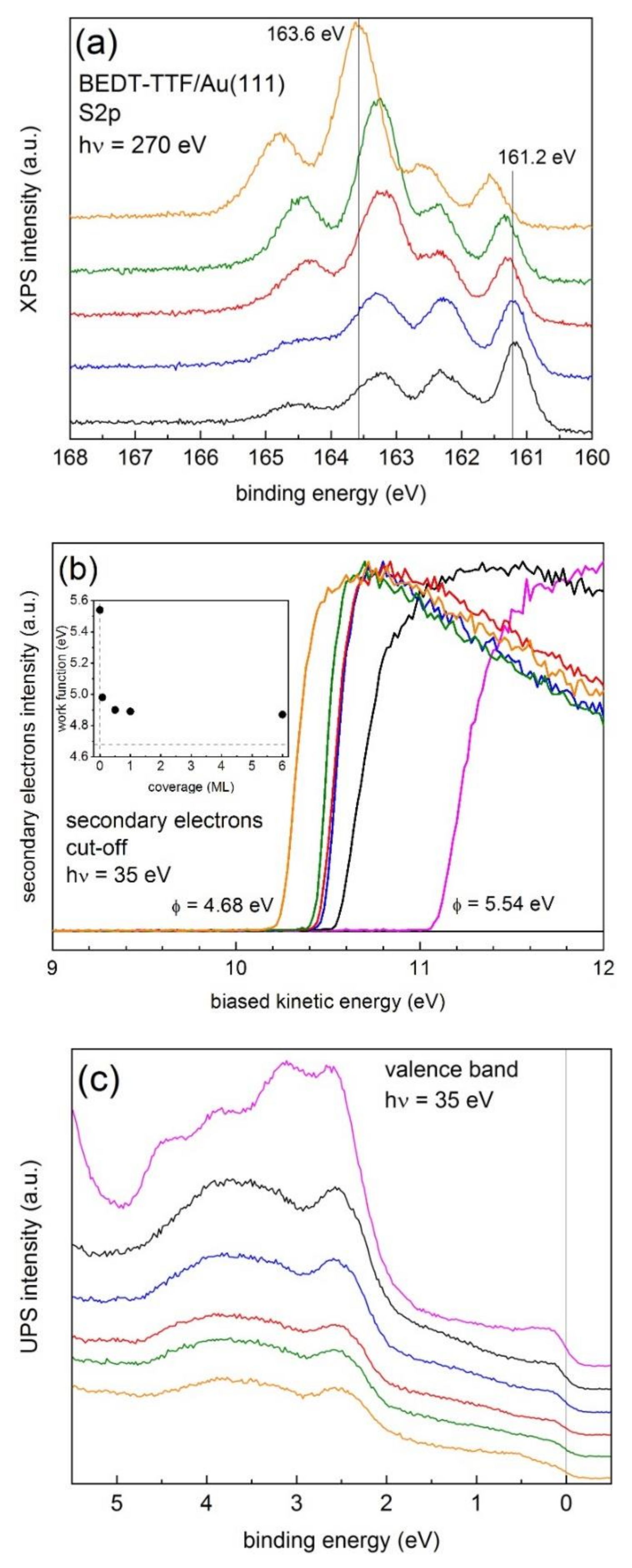

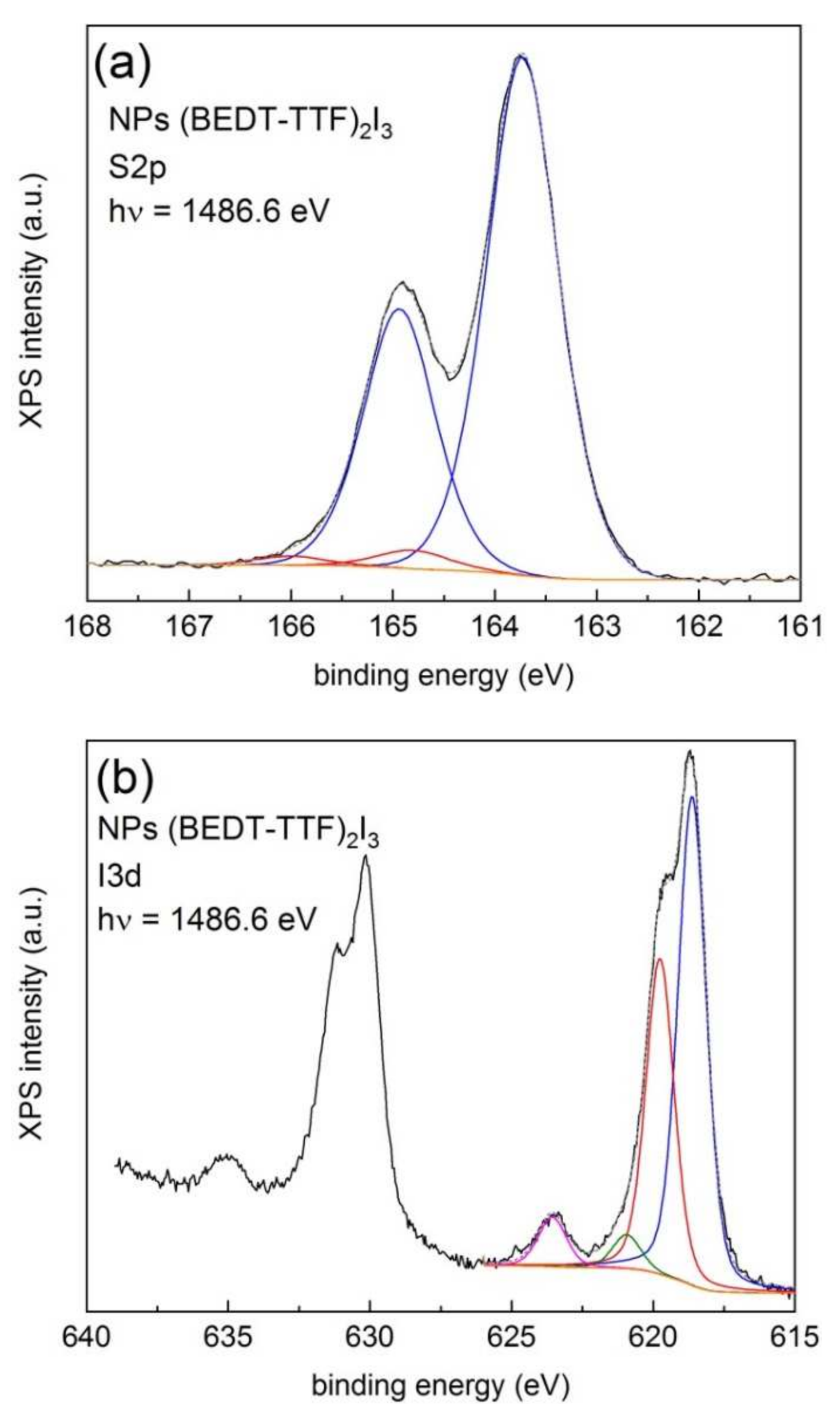
Publisher’s Note: MDPI stays neutral with regard to jurisdictional claims in published maps and institutional affiliations. |
© 2021 by the authors. Licensee MDPI, Basel, Switzerland. This article is an open access article distributed under the terms and conditions of the Creative Commons Attribution (CC BY) license (https://creativecommons.org/licenses/by/4.0/).
Share and Cite
Fraxedas, J.; Vollmer, A.; Koch, N.; de Caro, D.; Jacob, K.; Faulmann, C.; Valade, L. Characterization of Charge States in Conducting Organic Nanoparticles by X-ray Photoemission Spectroscopy. Materials 2021, 14, 2058. https://doi.org/10.3390/ma14082058
Fraxedas J, Vollmer A, Koch N, de Caro D, Jacob K, Faulmann C, Valade L. Characterization of Charge States in Conducting Organic Nanoparticles by X-ray Photoemission Spectroscopy. Materials. 2021; 14(8):2058. https://doi.org/10.3390/ma14082058
Chicago/Turabian StyleFraxedas, Jordi, Antje Vollmer, Norbert Koch, Dominique de Caro, Kane Jacob, Christophe Faulmann, and Lydie Valade. 2021. "Characterization of Charge States in Conducting Organic Nanoparticles by X-ray Photoemission Spectroscopy" Materials 14, no. 8: 2058. https://doi.org/10.3390/ma14082058
APA StyleFraxedas, J., Vollmer, A., Koch, N., de Caro, D., Jacob, K., Faulmann, C., & Valade, L. (2021). Characterization of Charge States in Conducting Organic Nanoparticles by X-ray Photoemission Spectroscopy. Materials, 14(8), 2058. https://doi.org/10.3390/ma14082058






